Originally, I planned to create my own mechanical puzzle for my final project. I drew inspiration from simple puzzles that I played with in my childhood. Due to time constraints, I decided that it may be difficult to come up with enough solution ideas to form an also aesthetically pleasing project. Therefore, I have changed my project focus to a Japanese-style jewelry box that incorporates a special mechanism to open a secret compartment. This idea comes from the inspiration to create a mechanical puzzle. I have chosen Japanese art because I have recently been exploring my interest in Japanese culture. I find the art form very refined and flowy — qualities that remind me of the beauty and elegance of jewelry.
I have already instigated a design change due to constraints. Often our most thought-intensive work happens at the last-minute, since, inevitably, things can go wrong. That is why the design change is important in the scope of time. Focusing on the Japanese aesthetic is a major constraint for me. I want to make something elegant (hopefully to give to my mother) that also represents its cultural references accurately. I have always taken an interest in Japanese culture, but all I have really been exposed to is anime — I wanted to explore beyond that. Materials are a constraint. I possess very few of the components that I want to use for this project, but I am certain that they will be easy to come by and few in numbers. Obviously I will need wood for the box. I’ll also need materials for the mechanisms that open the secret compartments, which are still to be determined. That being said, cost is a contributing constraint as well. Really high-end wood is expensive and as a college student, I can only afford to do so much. So I am setting myself a budget of around $50 for everything that I need to complete this project. Finally, skill is probably the most important constraint for my project. I am depending on being able to do a lot of woodworking, which I have done practically none of in the past. I also intend to do some wood-carving for the outer aesthetic of the box. I just picked up a carving kit for the first time a couple of days ago, so I am going to have to learn quite a bit about working with wood in a relatively short time frame.
The procedure for creating the prototype was relatively simple — it required only wood, a carving kit, acrylic paint, and wood glue. I obtained a small, thin strip of basswood and sectioned it off into 3″ x 3″ squares along the wood, by measuring and marking with a pencil. I decided to keep the strip intact during the process to make it easier to handle. After sectioning off the wood, I painted the first square black — the base for my aesthetic. I chose matte black as the background both because it was a common theme I found in an internet search of “Japanese Jewelry Boxes” and because I believe it adds to the elegant and somewhat serious nature of the aesthetic I am going for. I then proceeded to carve out random branch-like shapes to create the outline of a tree. The inspiration for this design can be seen in Figure 2, directly next to my design in Figure 1.
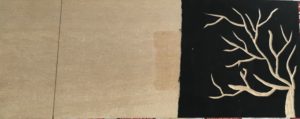
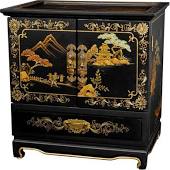
I really connected with the organic, flowy aesthetic that also proves itself to be refined and regal. I wanted to go with my own interpretation on how the box opens (top opening rather than drawers/cupboard) because I felt that it would make creating a secret compartment easier.
After doing my best to carve out a nature-themed, Japanese design for four of the sides, I used acrylic paint in woodland brown, forest green, and cherry blossom pink to paint in the carved portions, creating texture and depth that makes the features appear more realistic. For the top of the box, I included what I believe to be the Chinese letter for love on the top face of the box. I intended to use the appropriate Japanese character, but I think that Google may have led me astray. I used this letter because after deciding to create a jewelry box, I became determined to make something nice for my mother. Love was the one word I could think of that conveys the meaning I feel in giving this box to my mother — “mother” didn’t feel personal enough, and she is so much more to me than just a mother!
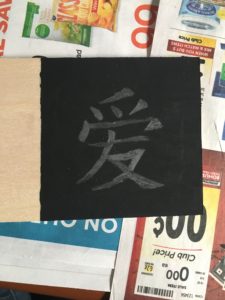
To assemble the sides of the box, I used wood glue on each of the edges until I had a fully assembled, stable box. A few of my friends pointed out that the sides were uneven or warped. This is mostly due to the fact that I did not use clamps when drying the wood glue, but merely held each side up for a couple of minutes. For the final project. I intend to make all of the edges coincident and to either use a mechanism that requires no wood glue, or use clamps to help the glue dry evenly and correctly.
The prototype itself is not functional — it is completely glued together, so it does not open. However, the final project will feature a hinge, a lock/latch, and a mechanism for opening a secret compartment. That being said, the prototype also does not have any internal features. I plan to drape some sort of red, silky fabric on the interior of the box likely along with a small amount of padding to reduce snags in the fabric and prevent jewelry from falling hard onto the wooden surface. The red is an aesthetic choice meant to enhance the elegance of the box.
I feel as though I achieved my aesthetic goals for the prototype in that I wanted to produce something that would convey the color scheme and basic design of a Japanese jewelry box. While there is still much work to do, I know now what changes and improvements I want to make to the aesthetic of my box. I hadn’t planned on making the prototype functional because I was more concerned with displaying the aesthetic. The final outcomes for each side can be seen in the images below.
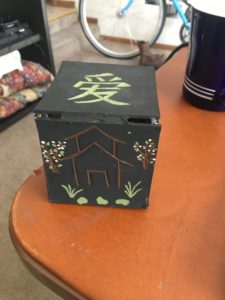
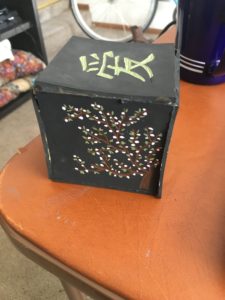
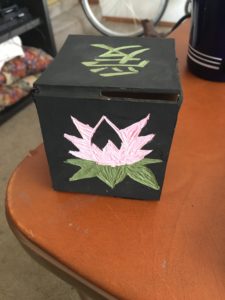
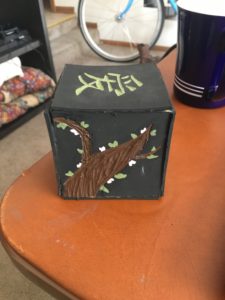
References:
Oriental Jewelry Box by wayfair(original artist unknown):
https://www.wayfair.com/Oriental-Furniture-Lacquer-Black-Crackle-Empress-Jewelry-Box

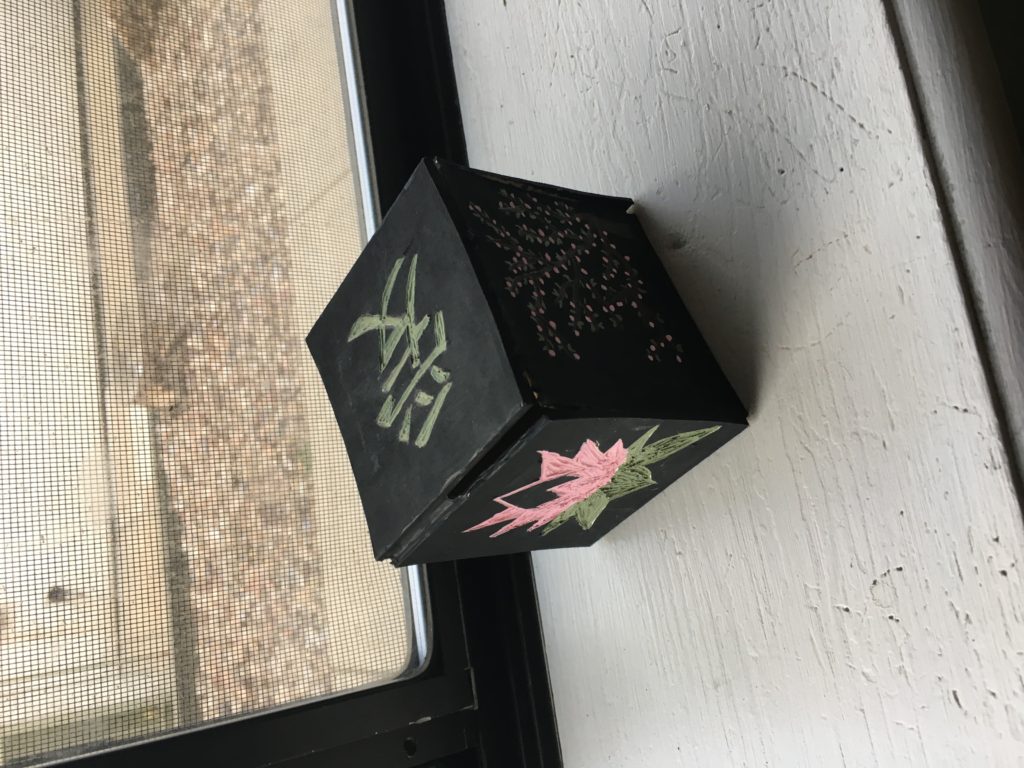
11 Comments. Leave new
Good job iterating to your final project. Japanese art is very intricate and beautiful. Adding love to it is a nice touch. Maybe try to use google translate for the word. I love how many different designs you already have experimented with. I was wondering about what the moving (or dynamic) part of your project is? Perhaps it could be a crank shaft to open up the box!
The dark looks great, especially with the carvings and paint. I would suggest more research into Japanese artistic styles for the period you want to model your piece after, rather than just other jewelry boxes. Products like that run the risk of being heavily Americanized or otherwise twisted away from the legitimate cultural aesthetic, but if you go into the research focused on historical Japanese art you are more likely to find definable trends, styles, colors, and subjects used in Japan as opposed to Chinese or Korean styles that Americans would be fooled by. I hope you find a way to attack the “hidden compartment” feature… I think that would even add to the “mysterious” aesthetic given the sleek, dark Asian imagery on the outside.
I like the Japanese aesthetic. What kind of wood do you plan to use? The painted designs are impressive, I don’t think I could have done that.
I am really excited to see the end product of your jewelry box because I love the Japanese aesthetic. Especially the black background! The carvings will definitely be a great addition as well. You mentioned that you needed some more ideas for Japanese symbols so here are two links that go to simplified cartoon images that might be helpful and simple to carve. Regardless, I like your choices of tree (maybe a cherry blossom), water lily, and temple.
(1) https://thumbs.dreamstime.com/z/china-icons-set-travel-asian-traditional-culture-symbols-isolated-vector-illustration-44407630.jpg
(2) https://thumbs.dreamstime.com/z/japanese-culture-symbols-set-classic-objects-representing-japan-white-background-75969553.jpg
Beautiful creation! While the matte black finish does provide it a nice organic feel, I suggest giving the box more of a glossy finish. Adding a glossy finish will give the box more of a ‘wealthy’ feel.
Do you think you will try to make a mechanical puzzle for any other future school projects? it sounds like a cool idea.
The aesthetic is really appealing. definitely makes you keep to some pretty specific design ideas which could be a challenge, so good work!
How large do you want this to be?
I like that it is black, it makes a nice contrast with the painted lotus flower. The dot work is really cool too! Do you have ideas for the mechanisms for opening the compartments? Id imagine that it will take a while to refine those mechanisms, but really worth it. You should look at the Japanese wood block prints for more inspiration on designs, they are beautiful.
I absolutely love the painted carvings on the box! The Japanese aesthetic is fascinating and the color palette that you chose goes well with the design. I really like the idea of secret compartments and the wood carvings are great. I like the symbolism in your design and great job on the prototype!
Your prototype is very artistic, it is a great start towards making your final jewelry box. The Japanese aesthetic is unique and I like how you are going to represent that aesthetic differently on each side of the box. Adding a secret compartment would be really neat but also adds a lot of complexity to the physical fabrication of the box.
The wood carvings look really nice in your prototype. I like the Japanese matte black finish. It brings out your carvings really well and gives a great aesthetic to your jewelry box. I know you wanted a simplistic aesthetic. But have you thought about including some curves to the box instead of having it like a simple cube?
Nice prototype! You can really see the vision for the final project. Maybe the Maker Space in the idea forge can help you create the dovetail joints.